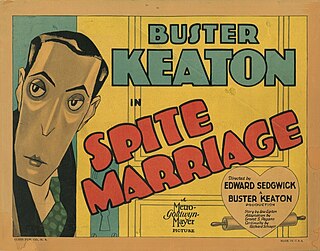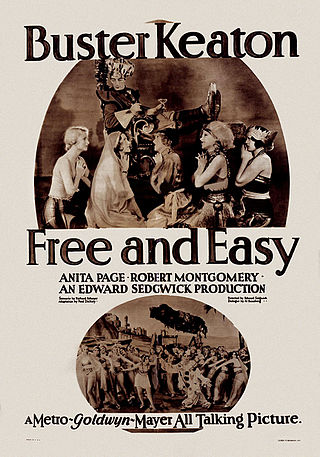Related Research Articles

Joseph Frank "Buster" Keaton was an American actor, comedian and filmmaker. He is best known for his silent films during the 1920s, in which he performed physical comedy and inventive stunts. He frequently maintained a stoic, deadpan facial expression that became his trademark and earned him the nickname "The Great Stone Face".

Edward Francis Cline was an American screenwriter, actor, writer and director best known for his work with comedians W.C. Fields and Buster Keaton. He was born in Kenosha, Wisconsin and died in Hollywood, California.

Educational Pictures, also known as Educational Film Exchanges, Inc. or Educational Films Corporation of America, was an American film production and film distribution company founded in 1916 by Earle Hammons (1882–1962). Educational primarily distributed short subjects; it is best known for its series of comedies starring Buster Keaton and the earliest screen appearances of Shirley Temple (1932–34). The company ceased production in 1938, and finally closed in 1940 when its film library was sold at auction.
David Freedman was a Romanian-born American playwright and biographer who became known as the "King of the Gag-writers" in the early days of radio.

Dorothy Sebastian was an American film and stage actress.

Marceline Day was an American motion picture actress whose career began as a child in the 1910s and ended in the 1930s.

Charles Lamont was an American filmmaker, known for directing over 200 titles and producing and writing many others. He directed nine Abbott and Costello comedies and many Ma and Pa Kettle films.

The Garage is a 1920 American two-reel silent comedy film directed by and starring Roscoe "Fatty" Arbuckle and featuring Buster Keaton. This was the fourteenth and last film starring the duo before Keaton set up his own studio and Arbuckle started making feature-length films. The film also stars Luke the Dog, who starred in many other short comedies with Arbuckle. The film was also known as Fire Chief.

Spite Marriage is a 1929 American silent comedy film co-directed by Buster Keaton and Edward Sedgwick and starring Keaton and Dorothy Sebastian. It is the second film Keaton made for MGM and his last silent film, although he had wanted it to be a "talkie" or full sound film. While the production has no recorded dialogue, it does feature an accompanying synchronized score and recorded laughter, applause, and other sound effects. Keaton later wrote gags for some up-and-coming MGM stars like Red Skelton, and recycled many gags from Spite Marriage, some shot-for-shot, for Skelton's 1943 film I Dood It.

Love Nest on Wheels is a 1937 Educational Pictures short subject directed by Buster Keaton and Charles Lamont. The film borrows heavily from Keaton's 1918 film The Bell Boy.

Earle W. Hammons, known professionally as E. W. Hammons, was an American film producer,. He produced more than 220 films between 1921 and 1938.

Allez Oop is a 1934 American short comedy film starring Buster Keaton. It was the second film Keaton made for Educational Pictures.
Tars and Stripes is a 1935 American Educational Pictures short comedy film directed by and starring Buster Keaton. The film was shot at Naval Training Center San Diego, California.
Grand Slam Opera is a 1936 American short comedy film starring Buster Keaton and produced by Educational Pictures.
The Chemist is a 1936 American short comedy film featuring Buster Keaton.
Mixed Magic is a 1936 American short comedy film starring Buster Keaton.

The Passionate Plumber is a 1932 American pre-Code comedy film directed by Edward Sedgwick, and starring Buster Keaton, Jimmy Durante, and Irene Purcell. The screenplay by Laurence E. Johnson and Ralph Spence is based on the 1926 play Dans sa candeur naïve by Jacques Deval. It is the second screen adaptation of the play, following the 1928 silent film The Cardboard Lover. It later was remade in 1942 as Her Cardboard Lover.

Joey Marion McCreery Lewyn, known professionally as Marion Mack, was an American film actress and screenwriter. Mack is best known for co-starring with Buster Keaton in the 1926 silent comedy film The General. After retiring from acting in 1928, she wrote several short screenplays and took up a career in real estate.

Free and Easy is a 1930 American pre-Code comedy film starring Buster Keaton. It was Keaton's first leading role in a talking motion picture.
Elsie Ames was an American comic dancer and film actress. Between 1937 and 1974 she acted in 15 films. She is best known as the female film partner of Buster Keaton.